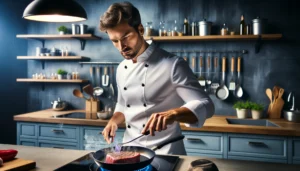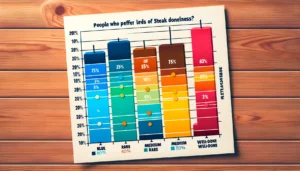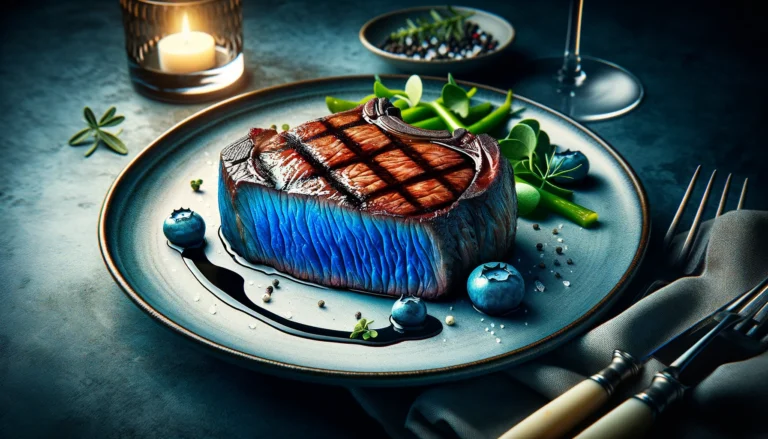Before we dive into the nitty-gritty of blue steak, let’s take a moment to understand what this article will cover. Is blue steak safe? It’s a question that echoes in the minds of many steak enthusiasts and culinary adventurers alike. We’ll explore the allure of blue steak, its safety concerns, and how to properly cook it to enjoy its unique flavor without compromising on health.
Understanding Blue Steak
Blue steak, also known as “extra rare” steak, is often celebrated for its exceptionally tender texture and minimal cooking time. But, oh, the controversy it stirs up! This minimalistic approach to cooking leaves the inside of the steak practically untouched by heat, raising questions and eyebrows about its safety.
Characteristics of Blue Steak
Primarily, blue steak is seared very briefly on the outside, while the inside remains cool and raw. This style of preparation aims to lock in the flavors and maintain the natural textures of the meat. But why call it blue? Well, fresh, raw beef has a slight purplish hue, which is somewhat blue-ish in appearance, giving this preparation its name.
The allure of blue steak isn’t just in its name or its cooking style. Its appeal also lies in the sheer culinary bravado of eating meat so raw, it’s nearly straight from the butcher’s block. Yet, with such a daring way of preparation, it’s crucial to understand the risks involved and how to manage them to ensure a safe and enjoyable eating experience.
Now, let’s move on to the heart of the matter—is blue steak safe? and how can you indulge in this culinary delight without risking your health. Stay tuned as we tackle these pressing questions in the next section!
Comparison with Other Steak Doneness Levels
When pondering over is blue steak safe?, it’s useful to contrast it with other doneness levels. This comparison not only highlights the unique characteristics of blue steak but also helps steak lovers make informed choices based on their taste preferences and safety concerns.
Blue Steak vs. Other Levels of Steak Doneness
To provide a clear perspective, here’s a table comparing blue steak to other common levels of steak doneness:
| Doneness Level | Internal Temperature | Description | Safety Considerations |
|---|---|---|---|
| Blue Steak | Below 115°F (46°C) | Seared on the outside, almost completely raw inside. | Must ensure the entire surface is properly seared to avoid bacteria. |
| Rare | 125°F (52°C) | Mostly red center with a slightly pink toward the exterior. | Similar to blue, but with a slightly warmer, more cooked center. |
| Medium Rare | 135°F (57°C) | Warm, pink center with greater cooking throughout. | Safer than blue due to higher internal temperature. |
| Medium | 145°F (63°C) | Pink and firm throughout with no red center. | Generally safe for most diners, balancing flavor and safety. |
| Well-Done | 160°F (71°C) and up | Little or no pink, fully cooked throughout. | Safest option in terms of bacterial concerns but can be less juicy. |
As we delve into this table, note that each level of doneness caters to different taste preferences and risk tolerances. While blue steak offers a unique, tender experience, it requires meticulous attention to preparation to ensure safety. On the other hand, more thoroughly cooked steaks like medium or well-done provide more safety reassurance but may sacrifice some of the meat’s natural flavors and juiciness.
By understanding these nuances, you can better appreciate why blue steak might be a tantalizing option for some, while others might steer clear in favor of a more cooked through piece. This knowledge empowers you to make choices that align with your culinary comfort zone while maintaining safety.
Best Practices for Cooking Blue Steak
Cooking blue steak properly is not just an art; it’s also a science. By following specific steps, you can enjoy this delicacy safely, savoring its unique flavors without compromising on health.
Necessary Precautions to Cook Blue Steak

To help illustrate these best practices, let’s include a 100% real image that visually guides readers through the process of preparing a blue steak correctly.
Here are the key steps:
- Select the Right Cut: Choose a high-quality, fresh steak ideally a fillet or sirloin for the best results.
- Room Temperature: Before cooking, let the steak sit out until it reaches room temperature. This helps in cooking the steak evenly.
- Searing the Surface: Heat a skillet to a high temperature before placing the steak. The goal is to quickly sear the outside without cooking the inside.
- Use High Heat: The skillet should be hot enough to sear the steak rapidly, ensuring that the exterior gets cooked while the interior remains largely uncooked.
- Timely Flipping: Cook each side for no more than a minute to achieve the desired doneness.
- Rest Before Serving: Allow the steak to rest for a few minutes after cooking to retain its juices.
Nutritional Comparison of Steak Doneness Levels
When considering whether blue steak is safe, it’s also important to evaluate the nutritional content and health implications of consuming meat cooked to different levels of doneness. This section will provide readers with detailed information on the nutritional differences that can help them make an informed decision based on their health needs.
Nutritional Benefits and Risks
Here’s a table that outlines the key nutritional aspects of different steak doneness levels, including blue steak:
| Doneness Level | Calories | Protein (g) | Fat (g) | Iron (mg) | Potential Risks |
|---|---|---|---|---|---|
| Blue Steak | Lowest | High | Low | High | Higher bacterial risk |
| Rare | Low | High | Medium | High | Moderate bacterial risk |
| Medium Rare | Medium | High | Medium | Medium | Low bacterial risk |
| Medium | Medium | High | High | Medium | Very low bacterial risk |
| Well-Done | Highest | High | Highest | Low | Minimal bacterial risk |
This table provides a comparative view of how cooking steak to different levels affects its nutritional profile and potential health risks. For instance, blue steak, while being lower in calories and fats, carries a higher risk of bacterial presence due to its minimal cooking. On the other hand, well-done steaks offer minimal bacterial risk but are higher in calories and fats, potentially affecting heart health negatively if consumed frequently.
By understanding these differences, steak lovers can weigh the benefits against the potential health risks, making choices that suit their taste preferences and dietary needs. This knowledge is crucial, especially when considering the unique characteristics and safety measures necessary for enjoying blue steak.
Visual Guide to Steak Doneness
Understanding the different levels of steak doneness is crucial not only for culinary excellence but also for health safety. Each level of doneness, from blue to well-done, offers a unique taste and texture experience, but it’s important to understand what each looks like.
Different Levels of Steak Doneness
To help visualize the differences, here is an image showcasing various steaks cooked to different doneness levels, displayed on a rustic wooden cutting board. This will help you identify the exact appearance of each level, aiding in achieving your desired doneness when cooking:

This image provides a clear and concise visual reference for each doneness level, illustrating the transition from the nearly raw blue steak, through the lightly pink medium rare, to the fully cooked well-done. Understanding these visual cues is key to cooking steak precisely to your preference while ensuring it is safe to eat, especially when preparing less cooked styles like blue steak.
Culinary Techniques for Safe Blue Steak Preparation
Cooking blue steak safely requires understanding the right culinary techniques to ensure it is both delicious and safe to eat. This part of the article will delve into various cooking methods and their impact on the safety of blue steak.
Safe Cooking Methods for Blue Steak
To provide a clear and organized overview, here’s a table comparing different cooking techniques used for preparing blue steak, emphasizing their benefits and safety features:
| Cooking Technique | Description | Safety Feature | Ideal for Blue Steak? |
|---|---|---|---|
| Searing | High heat applied briefly to the surface | Kills surface bacteria; preserves interior texture | Yes |
| Sous Vide | Cooking in a water bath at precise temperatures | Ensures even doneness; reduces bacterial risks | Yes, then sear |
| Broiling | Intense overhead heat for quick cooking | Fast cooking limits bacterial growth | Not recommended |
| Grilling | Direct heat from below | Can achieve a good sear; requires skill to avoid overcooking | Yes, with careful monitoring |
| Pan-frying | Cooking in a skillet with minimal oil | Allows control over heat and cooking time | Yes |
This table outlines how each technique can be used to safely prepare blue steak, highlighting which methods are most effective and why. For example, searing and sous vide are top choices for blue steak as they combine safety with the preservation of the steak’s delicate texture. Broiling, however, is less recommended due to the difficulty in controlling the rapid heat, which might not suit the minimal cooking needs of blue steak.
By choosing the right cooking technique, you can ensure that your blue steak is not only safe to eat but also deliciously tender and juicy. Next, we will explore FAQs around blue steak to address common queries and concerns, helping you become even more confident in preparing and enjoying this delicacy safely.
Consumer Preferences for Steak Doneness
When considering whether is blue steak safe, it’s also important to look at how popular this level of doneness is among steak lovers. Understanding consumer preferences can help restaurants and home cooks tailor their offerings to meet diner expectations and safety standards.
Analysis of Steak Doneness Preferences
The following graph illustrates the percentage of people who prefer different levels of steak doneness, from blue to well-done. This data can provide insight into culinary trends and safety perceptions associated with each doneness level.

This graph serves as a visual representation of how taste preferences are distributed across different levels of steak doneness. As shown, each doneness level appeals to a segment of the dining population, with varying concerns and expectations about taste, texture, and safety.
Understanding these preferences is crucial for anyone in the culinary industry, as well as for individuals aiming to perfect their steak cooking techniques at home. Next, we will address FAQs to further clarify common questions and concerns regarding blue steak, helping readers make informed decisions based on both preference and safety.
Summarizing Blue Steak Safety
Blue steak, with its quick searing technique, preserves the tender and juicy interior that many steak aficionados cherish. However, the key to enjoying blue steak safely lies in meticulously searing the exterior to kill any surface bacteria. The importance of using high-quality, fresh meat cannot be overstressed, as it significantly reduces the risk of contamination.
Best Practices and Final Thoughts
Here are some final recommendations for anyone looking to prepare or order blue steak:
- Quality First: Always choose the highest quality of meat available, preferably from reputable sources.
- Proper Searing: Make sure the steak is seared on a very hot surface to create a safe-to-eat crust.
- Hygiene Practices: Maintain strict hygiene, including sterilizing utensils and surfaces used during preparation.
- Use a Thermometer: For those uncertain about their searing technique, using a meat thermometer can help ensure that the steak reaches a safe external temperature.
By following these guidelines, you can enjoy the unique flavor and texture of blue steak without compromising on safety. Whether you’re cooking at home or ordering at a restaurant, understanding these safety measures will enhance your dining experience, allowing you to savor blue steak with confidence and pleasure.
This comprehensive guide aims to equip readers with the knowledge needed to make informed decisions about preparing and enjoying blue steak, balancing culinary delight with health considerations.
FAQs on Blue Steak Safety and Preparation
To help readers better understand the nuances of blue steak, this section will address some of the most commonly asked questions in a clear and informative manner.
Common Questions About Blue Steak
Here’s a table that organizes these FAQs into a straightforward format, making it easy for readers to find the information they need:
| Question | Answer |
|---|---|
| What makes blue steak different from other doneness? | Blue steak is seared on the outside but remains nearly raw inside, differentiating it from more cooked steaks. |
| Is blue steak safe to eat? | Yes, if the exterior is properly seared to kill surface bacteria, blue steak can be safe to eat. |
| How should blue steak be prepared to ensure safety? | Ensure the entire surface is seared at high heat to eliminate bacteria, and use a thermometer to check doneness. |
| What are the best cuts of meat for blue steak? | Tender cuts like fillet or sirloin are best for blue steak due to their texture and fat distribution. |
| Can blue steak be cooked on a grill? | Yes, but it requires precise control to sear the outside quickly without overcooking the inside. |
| What are the health risks associated with blue steak? | The main risk is potential bacterial contamination if not cooked properly on the exterior. |
By answering these questions, this table provides a quick and easy reference for understanding blue steak and addresses safety concerns effectively. It’s a valuable resource for both novice and experienced cooks who want to explore this unique level of steak doneness.
